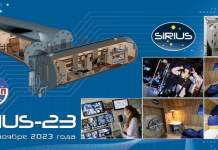SpaceX fire tests Starship SN11 prototype – launch expected this week
In preparation for the next launch of the Starship SN11 prototype to an altitude of about 10 km, SpaceX conducted static firing tests of the vehicle. Three Raptor SN11 engines (“Serial No. 11”) fired briefly yesterday (March 22) at 4:56 pm Moscow time at the company’s site in South Texas, near the village of Boca Chica on the Gulf Coast.

Static firing tests, during which the engines are fired, and the ship remains attached to the launch pad, are standard pre-flight testing for SpaceX rockets, including Starship prototypes. The upcoming SN11 flight could happen this week, at the earliest on March 24, based on the planned road closures in the Boca Chica area.
Interestingly, after the fire tests, some of the thermal protection tiles on the Starship prototype cracked and partially fell off. Recall: SpaceX is gradually starting to increase the number of heat shield tiles – if on SN8 they, in fact, were not there, then on SN11, they already cover a noticeable part of the rocket. Recently, a video was published showing how the company’s specialists fix them manually.
According to Elon Musk, many changes have been made to SN11 to correct deficiencies identified during previous tests. He explained that the SN10 prototype exploded after landing because the engines ran out of power due to helium leaking from the fuel tank. On March 3, SpaceX launched its Starship SN10 spacecraft to an altitude of 10 kilometers and managed to land the car, although the rocket exploded a few minutes after landing. This mission followed two other launches of Starship SN9 and SN8 to the same altitude – the prototypes managed to take off and perform the required maneuvers, but they crashed on landing. The company hopes SN11 will make a successful return and will not collapse during or after landing.
SpaceX makes changes and updates to the design of Starship prototypes after each test flight. The rocket is about 50 meters high – three Raptor rocket engines power current prototypes, and the final version will receive six such engines. The ship itself is just part of a huge, fully reusable system that will include, in addition to the Starship, a 70m Super Heavy first stage recoverable with 30 Raptor engines.
The company said Starship would eventually deliver up to 100-110 tons into low-earth orbit. NASA has selected Starship as one of three candidates to deliver astronauts and equipment to the Moon under the Artemis program. Japanese billionaire Yusaku Maezawa has already booked a SpaceX Starship flight around the moon for himself and eight other passengers. Starship could find many other uses in the future, including delivering people and cargo to Mars and even cleaning up space debris in Earth orbit. Elon Musk recently announced that SpaceX plans to launch the Starship orbital test flight this year. By the way, we recently saw the assembly of the first Super Heavy prototype – BN1 (“Accelerator number 1”).



